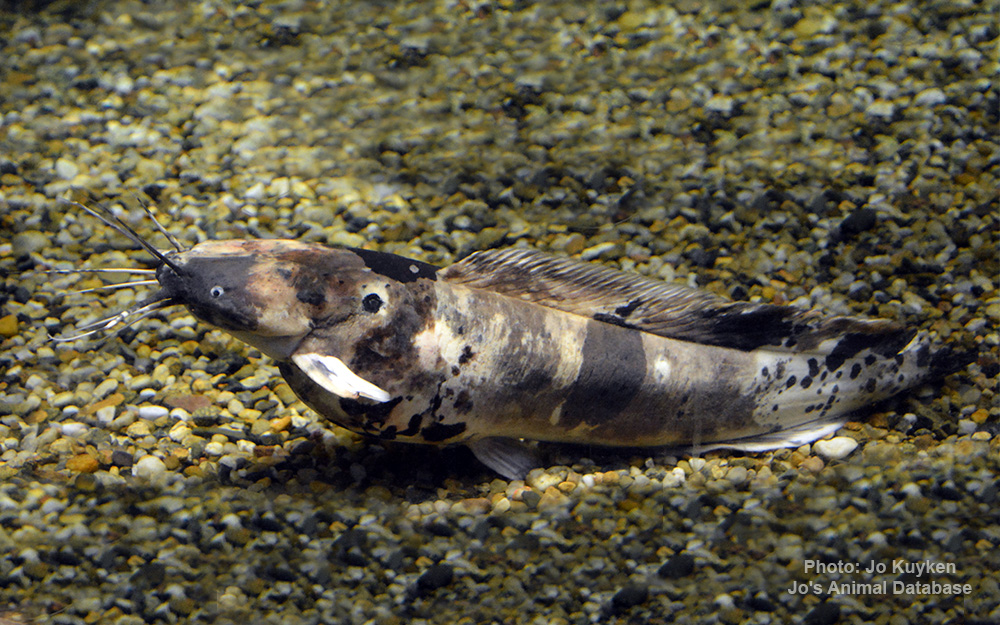Walking catfish
(Clarias batrachus)

Image source: Jo's Animal Database
Classification
General data
The walking catfish (Clarias batrachus) is a species of freshwater airbreathing catfish native to Southeast Asia. It is named for its ability to walk and wiggle across dry land, to find food or suitable environments. While it does not truly walk as most bipeds or quadrupeds do, it has the ability to use its pectoral fins to keep it upright as it makes a wiggling motion with snakelike movements to traverse land.
This fish normally lives in slow-moving and often stagnant waters in ponds, swamps, streams, and rivers, as well as in flooded rice paddies, or temporary pools that may dry up. When this happens, its walking skill allows the fish to move to other aquatic environments. Considerable taxonomic confusion surrounds this species and it has frequently been confused with other close relatives. One main distinction between the walking catfish and the native North American ictalurid catfish with which it sometimes is confused, is that the walking catfish lacks an adipose fin.
The native range of true Clarias batrachus is confirmed from the Indonesian island of Java only, but three closely related and more widespread species frequently have been confused with this species. These are C. magur of northeast India and Bangladesh, a likely undescribed species from Indochina, and another likely undescribed species from the Thai-Malay Peninsula, Sumatra, and Borneo. Both of these undescribed species have been referred to as, Clarias aff. batrachus. At present, the taxonomic position of the Philippines population (called hito or simply \\\\\\\\\\\\\\\\\\\\\\\\\\\\\\\"catfish\\\\\\\\\\\\\\\\\\\\\\\\\\\\\\\" by the locals) is unclear, and it also is unclear whether South Indian populations are C. magur or another species. As a consequence, much information (behavioral, ecological, related to introduced populations, etc.) listed for C. batrachus, may be for the closely related species that have been confused with true C. batrachus. True C. batrachus, C. magur and the two likely undescribed species are all kept in aquaculture.
As an invasive species
Within Asia, this species has been introduced widely. It has also been introduced outside its native range where it is considered an invasive species. It consumes the food supplies of native fish and preys on their young. It also is regarded as an invasive species because they can destroy fish farms.
In the United States, it is established in Florida. It is reported in California, Connecticut, Georgia, Massachusetts, and Nevada. The walking catfish was imported to Florida, reportedly from Thailand, in the early 1960s for the aquaculture trade. The first introductions apparently occurred in the mid-1960s when adult fish imported as brood stock escaped, either from a fish farm in northeastern Broward County or from a truck transporting brood fish between Dade and Broward Counties. Additional introductions in Florida, supposedly purposeful releases, were made by fish farmers in the Tampa Bay area, Hillsborough County in late 1967 or early 1968, after the state banned the importation and possession of walking catfish.
Aquarium releases likely are responsible for introductions in other states. Dill and Cordone (1997) reported this species has been sold by tropical fish dealers in California for some time. They also have been spotted occasionally in the Midwest.
In Florida, walking catfish are known to have invaded aquaculture farms, entering ponds where they prey on agricultural fish stocks. In response, fish farmers have had to erect fences to protect ponds. Authorities have also created laws that ban possession of walking catfish.
In 2017, Clarias spp. were recovered from the River Tonge, near Bolton, Northern England.















